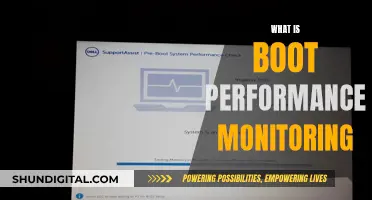
Monitoring transportation performance is essential for ensuring efficient, safe, and sustainable operations. Transportation systems are complex networks that facilitate mobility, accessibility, and connectivity for people and goods. By tracking key performance indicators (KPIs), transportation planners can enhance efficiency, reduce costs, and improve customer satisfaction. These KPIs provide quantitative or qualitative measures that reflect the performance and goals of the transportation system. For instance, KPIs can assess on-time delivery, average transit time, vehicle turnaround time, and transportation costs. In-vehicle monitoring technology also plays a crucial role in capturing safety-related data and encouraging safe driving practices. By understanding and analyzing these metrics, transportation professionals can make data-driven decisions to optimize transportation networks and improve overall performance.
What You'll Learn

Monitor key metrics like mobility, road safety, and accessibility
Monitoring transportation performance is essential for understanding how well a transportation system is serving its users and the wider community. Here are some ways to monitor key metrics like mobility, road safety, and accessibility:
Mobility
Mobility refers to the physical movement of people or goods. It involves measuring person- or ton-miles, and trip volumes, considering all modes of transportation, including private vehicles, public transit, walking, and cycling. To improve mobility, transportation planners aim to increase movement efficiency by reducing travel times and improving connections between different modes. This can be achieved through road and parking facility improvements, transit service enhancements, and better walking and cycling conditions.
Road Safety
Road safety is a critical aspect of transportation performance. Crash rates, which consider the number of crashes, traffic volume, and road segment lengths, are essential indicators for evaluating the relative safety of different roads or intersections. Safety performance indicators (SPIs) also play a vital role in understanding the effectiveness of road safety interventions and identifying gaps. These SPIs include factors such as the share of roads with speed limits, the presence of crash barriers, and the use of mobile devices while driving. By monitoring these metrics, transportation officials can identify areas of concern and implement targeted solutions to enhance road safety.
Accessibility
Accessibility refers to people's ability to reach desired goods, services, activities, and destinations. It considers all modes of transportation and recognizes that most travel has a destination. Accessibility-based planning expands the range of solutions beyond traditional mobility-based approaches. It involves improving walking conditions, enhancing public transit services, creating more accessible land use patterns, and providing mobility substitutes like telecommunications and delivery services. By adopting an accessibility perspective, transportation planners can make more inclusive decisions that benefit a broader range of users.
Monitoring Tools and Techniques
To effectively monitor these key metrics, transportation professionals employ various tools and techniques. Data collection methods include traffic volumes, transit ridership data, location-based data from smartphones or Bluetooth devices, crash data, and road segment lengths. Additionally, performance indicators such as average daily traffic (ADT) and annual average daily traffic (AADT) help quantify road busyness. Other indicators like corridor travel times, vehicle miles traveled (VMT), and peak hour factor (PHF) provide insights into traffic flow and congestion. By analyzing these metrics and indicators, transportation professionals can make informed decisions to optimize transportation systems and enhance the overall quality of life for residents.
Adjusting Monitor DPI on Your MacBook Pro
You may want to see also

Measure average daily traffic (ADT) and annual average daily traffic (AADT)
Measuring average daily traffic (ADT) and annual average daily traffic (AADT) is a crucial aspect of transportation planning, engineering, and retail location selection. These metrics provide valuable insights into the volume of traffic on highways or roads, helping to determine how busy a specific stretch of the road is.
ADT refers to the average 24-hour traffic volume at a given location for a period of less than a year. It can be calculated by taking repeated daily counts of traffic volumes over a week and then dividing the sum of all counts by the number of days. This metric is particularly useful for understanding traffic flow and addressing issues such as traffic jams and slow speeds.
On the other hand, AADT is a theoretical estimate of the total number of vehicles using a specific segment of the roadway in both directions on any given day of the year. It is calculated by taking the total volume of vehicle traffic on a highway or road for a year and dividing it by 365 days. AADT is widely used as a standard measurement for vehicle traffic load and plays a crucial role in transport planning and addressing environmental hazards related to road transport.
To enhance the accuracy of AADT calculations, it is recommended to refer to historical AADT data in addition to the most current information. Construction activities can impact traffic patterns, so collecting traffic data before or after a project starts is ideal. Additionally, AADT calculations should consider variations in traffic over months, days of the week, and hours of the day.
AADT is also essential for determining funding allocations for highway maintenance and improvement. In the United States, federal funding for states is based on total traffic measured across their highway networks, with each state's Department of Transportation submitting an annual Highway Performance Monitoring System (HPMS) report.
Calculating ADT and AADT is a complex process that requires careful data collection and analysis. These metrics are essential for making informed decisions about transport systems, ensuring they function efficiently, safely, and sustainably.
Monitors: VGA vs. HDMI — Which Connection is Superior?
You may want to see also

Calculate vehicle miles travelled (VMT)
Vehicle Miles Travelled (VMT) is a critical metric in transportation planning and policy-making. It measures the total distance travelled by vehicles on a specific road or network of roads over a certain period. VMT is a useful metric for understanding traffic congestion, environmental impact, energy consumption, and economic activity.
To calculate VMT, you need to know the total number of vehicles passing through a road or network of roads over a given period, as well as the length of the road or roads. This data is then used in the following formula: VMT = Annual Average Daily Traffic (AADT) x road segment length x 365. This calculation gives you the VMT for that specific road or network of roads. To get the VMT for a larger geographical area, you would then sum the VMT of all the individual roads or road networks within that area.
For example, if you want to calculate the VMT for a particular highway over a year, you would first need to determine the AADT for that highway. Let's say the AADT is 10,000 vehicles, and the highway is 100 miles long. Using the formula, the calculation would be: 10,000 x 100 x 365 = 3,650,000. So, the VMT for that highway over a year is 3,650,000 miles.
It is important to note that calculating VMT for a large geographical area can be challenging and time-consuming due to the vast amount of data required. Typically, this data is collected through surveys, which may not always be accurate or representative. Despite this challenge, VMT remains a crucial metric for transportation planning and policy decisions.
Compatibility of ASUS Monitors with VESA Mounts
You may want to see also

Assess on-time and in-full (OTIF) deliveries
OTIF, or On Time In Full, is a key metric for assessing transportation performance. It evaluates the proportion of deliveries completed successfully, meaning the customer receives what was ordered, in the quantity ordered, at the correct location, and within the agreed-upon timeframe.
The Significance of OTIF
OTIF is important for several reasons. Firstly, it improves customer satisfaction, especially with the growth of e-commerce, where timely deliveries and keeping promises to customers are essential for acquiring and retaining customers. Secondly, it leads to cost savings and operational efficiency. By incentivizing accurate and timely deliveries, OTIF helps retailers avoid maintaining excess stock, reducing storage and warehousing costs. It also optimizes transportation and logistics spending by reducing the need for last-mile deliveries, which can account for a significant portion of an organization's logistics costs.
Factors Affecting OTIF Performance
Several factors can influence a company's ability to achieve high OTIF rates:
- Inventory Management: Effective inventory management ensures that products are available when needed for delivery. Inaccurate inventory management can lead to delays and incomplete orders.
- Transportation and Logistics: Efficient transportation and logistics operations are crucial for meeting delivery deadlines. Poor route planning or inefficient transportation can hinder OTIF targets.
- Supplier Performance: Suppliers are essential for OTIF performance. Timely and accurate deliveries from suppliers are vital for meeting customer expectations.
- Demand Forecasting: Accurate demand forecasting helps plan inventory levels, production, and transportation schedules, ensuring products are available for on-time delivery.
Strategies for Improving OTIF Performance
To achieve high OTIF rates, consider the following strategies:
- Demand Forecasting and Inventory Optimization: Invest in demand forecasting tools and combine this with inventory optimization to ensure the right products are available.
- Efficient Transportation and Route Planning: Use advanced route planning software to optimize delivery routes, reduce transit times, and lower transportation costs.
- Supplier Collaboration and Communication: Establish strong relationships with suppliers and clearly communicate expectations. Collaboration with suppliers can lead to better OTIF performance.
- Technology and Automation Solutions: Embrace technology and automation to streamline order processing, tracking, and reporting. Real-time visibility into the supply chain enables proactive resolution of potential issues before they impact OTIF performance.
Calculating OTIF
To calculate OTIF, you need to:
- Determine the total number of deliveries in a defined period.
- Calculate the number of deliveries that were made on time from the total deliveries.
- From the deliveries that were on time, count the number of deliveries that were completed in full (no loss, damage, etc.).
- Divide this number by the total number of deliveries to obtain the OTIF rate for that period.
Challenges and Common Pitfalls
Achieving a high OTIF score is challenging due to issues like a lack of real-time visibility into shipments, outdated technologies that slow down order processing, poor supplier performance, inaccurate demand forecasting, and poor carrier communication.
Cutting Ankle Monitors: Stealthy Techniques for Removing Electronic Tags
You may want to see also

Evaluate road transportation cost per unit
When it comes to road transportation, there are several factors that can impact the cost per unit. Here are some key considerations to keep in mind when evaluating road transportation costs:
Fixed and Variable Costs
Fixed costs refer to expenses that remain relatively constant regardless of the usage or volume of goods transported. Examples of fixed costs in road transportation include vehicle excise duty, vehicle insurance, operator's licence fees, driver wages, depreciation, and overhead costs. On the other hand, variable costs are those that fluctuate depending on the usage or volume of goods transported. Fuel costs, lubricants, tyres, repairs, and maintenance are examples of variable costs.
Distance Travelled
The distance travelled is a significant factor in determining the cost per unit for road transportation. Longer distances typically result in higher transportation costs due to increased fuel consumption, driver wages, and other operational expenses.
Weight and Volume of Goods
The weight and volume of the goods being transported can also impact the cost per unit. Heavier or larger cargo may require specialised equipment or additional vehicles, increasing the overall transportation cost.
Route Selection
The choice of route can significantly affect the cost per unit for road transportation. Certain routes may have higher tolls, fuel costs, or other charges, while others may offer more direct or efficient paths.
Type of Vehicle
The type of vehicle used for road transportation can impact the cost per unit. Larger or specialised vehicles may have higher associated costs, including fuel consumption, maintenance, and driver requirements.
External Costs
External costs refer to expenses that are not directly related to the transportation provider but can impact the overall cost of the service. Examples of external costs include environmental impacts, congestion, accidents, and infrastructure development.
Economies of Scale
Economies of scale come into play when larger shipment sizes are transported, resulting in lower unit transportation costs. This is particularly evident in road transportation, where larger trucks or trailers can carry more goods at a lower cost per unit.
Operational Efficiency
The operational efficiency of the transportation company can also impact the cost per unit. Efficient processes, such as optimised routing, timely deliveries, and minimised empty backhauls, can help reduce the overall transportation cost.
Regulatory and Tariff Costs
Regulatory requirements, such as tariffs, cabotage laws, labour regulations, security, and safety standards, can add to the cost per unit for road transportation. These costs may vary depending on the geographic region and the specific regulations in place.
Fuel Costs and Surcharges
Fluctuations in fuel prices can significantly impact the cost per unit for road transportation. Additionally, surcharges, such as fuel surcharges, security fees, and additional baggage fees, can further increase the overall transportation cost.
By considering these factors and conducting thorough research, businesses can effectively evaluate and optimise their road transportation costs per unit. This evaluation process is crucial for making informed decisions, improving efficiency, and ensuring cost-effectiveness in road transportation operations.
Standard Monitor Size: Understanding 1366x768 Resolutions
You may want to see also
Frequently asked questions
Some commonly used transportation performance indicators include:
- Vehicle Miles Travelled (VMT)
- Crash Rates
- Peak Hour Factor (PHF)
- Mode Share
- Transit Accessibility
- Vehicle Turnaround Time
- Vehicle Fill Percentage
- Average Transportation Cost
Transportation Key Performance Indicators (KPIs) are measurable values that indicate how effectively a company progresses towards its business objectives. They are also a way of comparing a company's performance to others in the same industry.
Transportation KPIs are important because they help shippers measure their team's performance, cut costs, and improve customer satisfaction. Monitoring KPIs helps businesses keep their processes efficient, reduce costs, and attract and retain customers.
Some examples of transportation KPIs include:
- On-Time and In-Full (OTIF)
- Average Delivery Time
- Average Days Late
- Truck Turnaround Time
- Average Transportation Cost
- Freight Bill Accuracy







